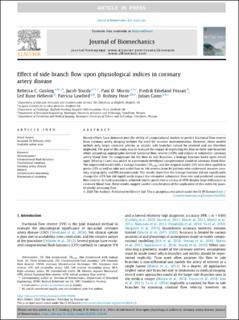| dc.contributor.author | Gosling, Rebecca C. | |
| dc.contributor.author | Sturdy, Jacob | |
| dc.contributor.author | Morris, Paul D. | |
| dc.contributor.author | Fossan, Fredrik Eikeland | |
| dc.contributor.author | Hellevik, Leif Rune | |
| dc.contributor.author | Lawford, Patricia V. | |
| dc.contributor.author | Hose, David Rodney | |
| dc.contributor.author | Gunn, Julian P. | |
| dc.date.accessioned | 2021-04-16T07:31:57Z | |
| dc.date.available | 2021-04-16T07:31:57Z | |
| dc.date.created | 2020-03-04T14:57:39Z | |
| dc.date.issued | 2020 | |
| dc.identifier.citation | Journal of Biomechanics. 2020, 103 . | en_US |
| dc.identifier.issn | 0021-9290 | |
| dc.identifier.uri | https://hdl.handle.net/11250/2738009 | |
| dc.description.abstract | Recent efforts have demonstrated the ability of computational models to predict fractional flow reserve from coronary artery imaging without the need for invasive instrumentation. However, these models include only larger coronary arteries as smaller side branches cannot be resolved and are therefore neglected. The goal of this study was to evaluate the impact of neglecting the flow to these side branches when computing angiography-derived fractional flow reserve (vFFR) and indices of volumetric coronary artery blood flow. To compensate for the flow to side branches, a leakage function based upon vessel taper (Murray’s Law) was added to a previously developed computational model of coronary blood flow. The augmented model with a leakage function (1Dleaky) and the original model (1D) were then applied to predict FFR as well as inlet and outlet flow in 146 arteries from 80 patients who underwent invasive coronary angiography and FFR measurement. The results show that the leakage function did not significantly change the vFFR but did significantly impact the estimated volumetric flow rate and predicted coronary flow reserve. As both procedures achieved similar predictive accuracy of vFFR despite large differences in coronary blood flow, these results suggest careful consideration of the application of this index for quantitatively assessing flow. | en_US |
| dc.language.iso | eng | en_US |
| dc.publisher | Elsevier Science | en_US |
| dc.rights | Navngivelse 4.0 Internasjonal | * |
| dc.rights.uri | http://creativecommons.org/licenses/by/4.0/deed.no | * |
| dc.title | Effect of side branch flow upon physiological indices in coronary artery disease | en_US |
| dc.type | Peer reviewed | en_US |
| dc.type | Journal article | en_US |
| dc.description.version | publishedVersion | en_US |
| dc.source.pagenumber | 9 | en_US |
| dc.source.volume | 103 | en_US |
| dc.source.journal | Journal of Biomechanics | en_US |
| dc.identifier.doi | 10.1016/j.jbiomech.2020.109698 | |
| dc.identifier.cristin | 1799625 | |
| dc.description.localcode | This is an open access article distributed under the terms of the Creative Commons CC-BY license, which permits unrestricted use, distribution, and reproduction in any medium, provided the original work is properly cited. | en_US |
| dc.source.articlenumber | 109698 | en_US |
| cristin.ispublished | true | |
| cristin.fulltext | original | |
| cristin.qualitycode | 2 | |

